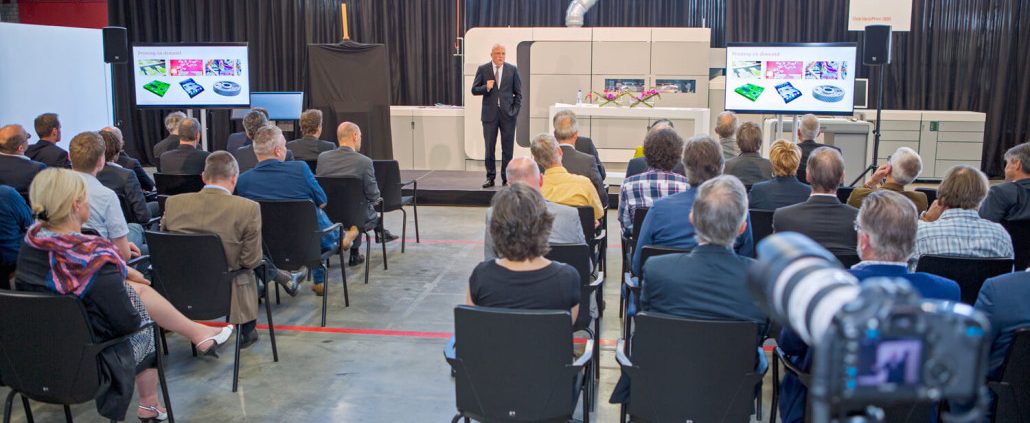Océ and partners invest in future of inkjet technology
Kickoff of €6.3 million research program
Venlo, 27 September 2016
On Tuesday September 27th, the official kickoff of a €6.3 million inkjet research program took place at Océ headquarters in Venlo, the Netherlands. The resulting knowledge will be used to develop future generations of Océ printers. The results can also be used in the jetting of materials other than ink. High-speed jetting technology has the potential to be applied in digital manufacturing techniques and revolutionize the way we make things.
The program is titled Fundamental Fluid Dynamics Challenges in Inkjet Printing, abbreviated FIP. It is a unique cooperation between the Foundation for Fundamental Research on Matter (FOM), the Eindhoven University of Technology (TU/e), the University of Twente (UT) and Océ. The FIP program will focus on the research of complex fluid dynamics phenomena, including the interactions with the print heads and substrates.
The program will last 6 years, and represents an investment of €6.3 million. It will involve 12 PhD studies, 4 2-year PostDocs and 2 FOM group leaders. Océ will contribute half of the program’s budget. The other half will come from FOM Industrial Partnership Programme (IPP) funds and the Impulse programs of TU/e and UT.
A tradition of cooperation
The FIP program will be coordinated by Detlef Lohse, Professor and Chair of Physics of Fluids, University of Twente. The research will focus on drop formation, the prevention of air bubbles and the drying of drops on paper. It will also explore the interaction between ink and different types of substrates. The findings will contribute to the development of the inkjet technology of the future.
FIP will be the largest and most comprehensive inkjet study of its kind ever conducted in the Netherlands. It is a unique cooperation among the 4 partners and forms the basis for long-term cooperation between leading research groups in this field in the Netherlands.
Anton Schaaf, CEO, Océ Holding B.V.: “In the past, we had several projects and programs with the 3 different research institutes, but many of these are ending. This new long-term research program gives us the unique opportunity to continue and combine the vast range of expertise available, to take our inkjet innovation to a new level.”
Printing on demand
Most people are familiar with inkjet technology in desktop printers. At Océ, inkjet is used in high- speed production printing systems that produce up to 1714 full-color A4 images per minute. The market for high-speed inkjet printing is growing rapidly. For instance, digital book printing is growing by 15% per year. Digital book printing on demand eliminates the need for large inventories of books, and there is no waste of unsold books. Books can be printed close to consumers in local markets, with reduced shipping costs and simplified logistics.
With inkjet technology, printing on demand is moving beyond paper. Users of Océ systems are printing product packaging on demand. They are printing directly onto interior décor and building materials, such as textiles, wall paper, panels, wood and glass. Today, printing on demand is even moving beyond the printing of images. It is already possible to print ‘functionality’. In pilot projects, Océ jetting techniques are printing resist directly onto copper for the production of printed circuit boards. Another example is the printing of coatings onto OLED screens.
Related Posts
Océ in Dutch R&D Top 10
12/07/2018 NewsIn May 2018, the Dutch magazine Technisch Weekblad published their yearly R&D Top 30 for companies in the Netherlands. The top R&D investor in the Netherlands is ASML. Philips takes the second place. The list is rounded off with Océ at number 10.
Learn moreOcé supports research project Mauritshuis museum
21/02/2018 NewsThe Mauritshuis museum in The Hague has asked Océ, a Canon company, to print a copy of ‘The Girl with the pearl earring’ for visitors who still want to admire Vermeer’s masterpiece while the original is being vetted.
Learn more







